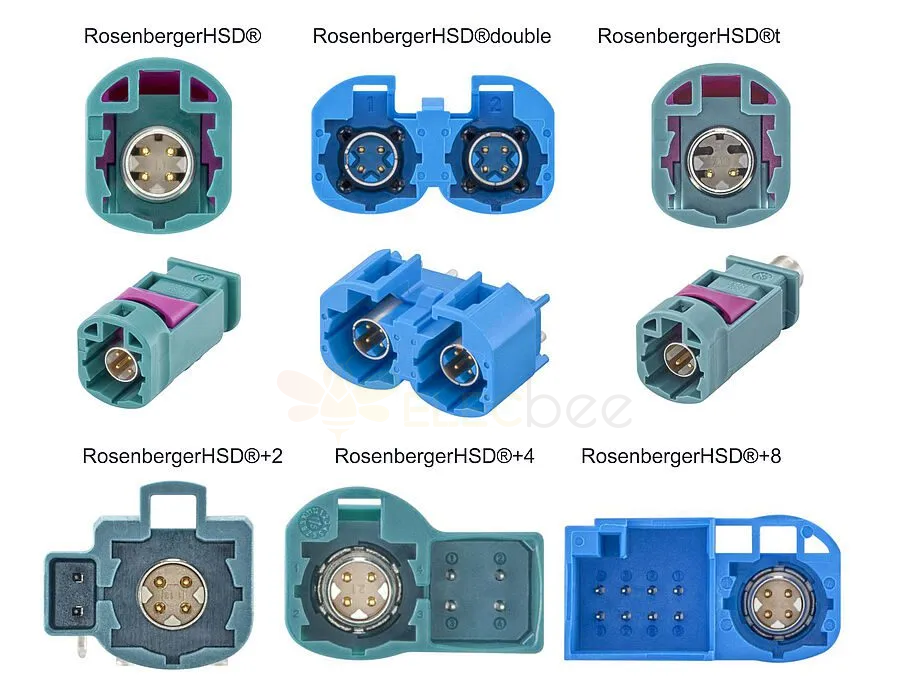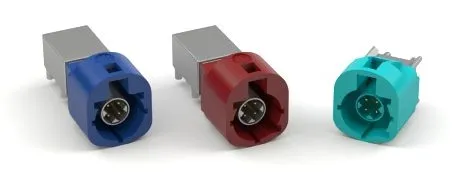HSD connectors are part of an industry-wide effort to meet the growing demand for high-speed, reliable data transmission in automotive and industrial applications. The concept and design grew out of a collaboration between connector manufacturers, including Rosenberger and TE Connectivity, to standardize data communication interfaces for applications such as Ethernet, USB, and LVDS, which are used in the automotive industry for infotainment systems, cameras, and Advanced Driver Assistance Systems (ADAS), as well as automation systems in industrial environments.

Rosenberger’s HSD interface is the result of collaboration with OEMs and Tier 1 suppliers to promote its adoption as an industry standard.
01
Design Notes
Standardization
The HSD complies with Automotive Open Systems Architecture (AUTOSAR) connector requirements, ISO and IEC standards, and protocols including USB, LVDS (Low Voltage Differential Signaling), Ethernet (IEEE 802.3), Firewire (IEEE 1394), APIX (Digital Serial Link for point-to-point applications for displays and cameras), CAN (Controller Area Network), and PCIe. protocols including Firewire (IEEE 1394), APIX (digital serial link for point-to-point applications for displays and cameras), CAN (Controller Area Network), MHL (Mobile High Definition Link), and PCIe.
HSD Connector Mounting Types
Wire-to-board mounting types or wire-to-wire connections are typically used, depending on the application.
Mating Frequency
Typical HSDs are rated for up to 500 cycles.
Position
HSDs are available in 2 to 12 positions, depending on functional requirements.
Dimensions
Width: 10 mm to 25 mm, depending on the number of positions.
Height: 5 mm and 15 mm.
Length: 20 mm to 40 mm.

Adam Tech's HSD FAKRA connectors fulfill the RF requirements for a variety of telematics and multimedia applications, including Satellite Digital Audio Radio Service (SDARS), Global System for Mobile Communications (GSM) and Global Positioning System (GPS).
Contacts
Pins: 2 to 12
Pitch/spacing: 1.27 mm
Height: 5 to 15 mm
Contact resistance: Low; approximately 0.05 to 0.10 ohms per contact
Termination: Solder, crimp, crimp or screw-in
Material specifications
The housing is usually made of polyamide (PA) or PBT (polybutylene terephthalate) for high strength, heat resistance and good electrical insulation. Thermoplastic elastomers (TPEs): used for overmolding and gasketing to provide flexibility and sealing performance for environmental protection.
Physical Properties
Insulation: HSD connectors typically utilize thermoplastic insulating materials with high dielectric strength to ensure reliable signal integrity and electrical insulation.
Shielding: In addition, connectors typically feature metal shielding to minimize electromagnetic interference (EMI), further enhancing signal insulation and protecting the integrity of high-speed data transmission.
Locking Mechanisms: Connectors are also equipped with locking mechanisms such as snap-in or bayonet locks to ensure secure mating in high vibration environments such as automotive or industrial applications.

TE Connectivity's fully shielded HSD connector system supports LVDS, Ethernet, and USB protocols and features a full range of splices and connectors for unsealed and sealed applications.
01 Environmental Features
IP Rating/Sealing Mechanism: Ruggedized HSD connectors can be designed to meet IP67 or IP69K standards.
Reinforcement: Features may include metal shielding, gaskets, high temperature resistant materials and vibration resistance.
Temperature range: -40 °C to +105 °C or higher for automotive applications.
Electrical Characteristics
Voltage AC/DC: typically 5V to 12V
Current (amps): up to 1A per contact (or less in most cases).
02 Markets and Applications
Automotive, Consumer Electronics, Industrial
In automotive applications, HSD connectors are used for advanced driver assistance systems (ADAS); display, audio, and multimedia interfaces; GPS, vehicle-to-vehicle (V2V), and vehicle-to-infrastructure (V2X) communications; and camera systems. In industrial environments, they play a role in robotics, machine vision systems, and test and measurement systems. They are also used in some displays and VR headsets.
Learn more about elecbee HSD Connector

